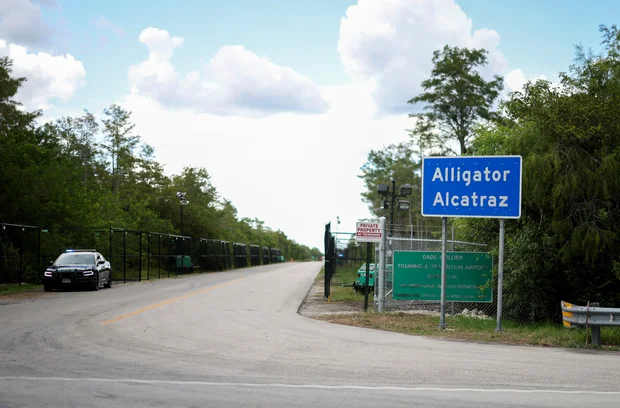Homeland Security Secretary Kristi Noem announced that “Alligator Alcatraz” will become the blueprint for state-run migrant detention centers. She told CBS News she plans to open several similar facilities in multiple airports and jails nationwide within the coming months. Officials are already considering potential sites in Arizona, Nebraska, and Louisiana.
“The locations we’re looking at are right by airport runways, which will give us an efficiency we’ve never had before,” Noem said. She added that she has reached out to governors and state leaders nationwide to gauge interest in joining the Trump administration’s push to detain and deport more unauthorized migrants.
According to Noem, most leaders are on board—especially in states that support President Trump’s mission to secure the southern border—because “many have facilities that may be empty or underutilized.”
This strategy builds on the launch of a 3,000-bed immigration detention center at a South Florida jetport last month. Nicknamed Alligator Alcatraz by state and federal officials, the temporary facility cost an estimated $450 million to operate in its first year and was built in just eight days. Located at Dade-Collier Training and Transition Airport, it sits in 39 square miles of remote swampland surrounded by hazardous terrain and wildlife.
When President Trump toured the site last month, he saw rows of bunk beds behind chain fences topped with razor wire. He joked to reporters, “We’re going to teach them how to run away from an alligator if they escape prison.” Asked if this would be the model for future facilities, Trump said he’d like to see similar setups “in many states.”
Interest From States
Arizona’s governor’s office told CBS News they have not been approached about a facility. Nebraska Governor Jim Pillen’s office said they remain in talks with federal partners but called it “premature to comment” until more details are finalized.
Noem praised the Alligator Alcatraz model as “much better” than the current system, which largely contracts detention services to private prison companies and county jails under intergovernmental service agreements (IGSAs). DHS officials said the Florida site costs about $245 per inmate bed, per night—cheaper than previous DHS contracts.
In comparison, the Office of Homeland Security Statistics estimates the average daily cost of detaining an adult migrant in fiscal year 2024 was about $165, though rates vary by region, stay length, and facility type.
Noem argued that placing detention centers near airports will further cut costs by speeding up processing. “They’re all strategically designed to keep people in beds for fewer days,” she explained. Some facilities are still under review and in active negotiations.
Funding and Capacity Expansion
Unlike Alligator Alcatraz, funded through FEMA’s shelter, food, and transportation program, the new state-based initiative will draw from a $45 billion fund created by President Trump’s recently signed bill. This fund will nearly double ICE’s bedspace from 61,000 to more than 120,000 beds. As of Saturday, ICE housed just over 57,000 people in more than 150 facilities nationwide.
Noem, who personally approves every DHS contract or grant over $100,000, now limits ICE detention contracts to under five years. Alligator Alcatraz, for instance, operates on a one-year renewable contract.
“Why are we signing 15-year deals?” she asked. “If we’re still building out and processing 100,000 detention beds 15 years from now, we didn’t do our job.”
This marks a shift from earlier Trump-era agreements, such as February’s 15-year, $1 billion ICE contract with private prison giant GEO Group to reopen Delaney Hall in the Northeast.
Despite this, Noem said she is not abandoning private detention entirely: “I want everybody at the table with solutions. But I want contracts that do the job—not ones that keep people in detention beds just to make money.”
Legal and Human Rights Challenges
Alligator Alcatraz faces legal challenges from attorneys claiming the Trump and DeSantis administrations are detaining people without charges or access to immigration courts. They argue detainees at the Florida-run site lack legal recourse to challenge their detention.
Experts question whether states have the authority to run immigration detention centers, since immigration enforcement is a federal responsibility. A U.S. district judge has ordered officials to produce the agreement outlining “who’s running the show” at the Everglades site.
Kevin Landy, former ICE detention policy director under President Obama, said, “Florida does not have the legal authority to detain undocumented immigrants without a contract with ICE. A state government can’t do that.”
Detainees have also alleged unsanitary and inhumane conditions—such as maggot-infested food, denial of religious rights, and limited access to lawyers and water—claims Florida officials deny.
Deterrence as a Strategy
Tucked 45 miles west of Miami in the Everglades, the site’s isolation is intentional. “There definitely is a message it sends,” Noem said. “If you’re a violent criminal here illegally, there will be consequences.”
She believes deterrence works, citing intelligence from U.S. agencies and Latin American countries showing that fear of consequences drives many migrants to return home voluntarily.
In March, Noem asked Mexican President Claudia Sheinbaum how many people had returned since Trump took office. Sheinbaum estimated between 500,000 and 600,000 have voluntarily gone back to Mexico, fearing they may lose the chance to return legally in the future.
Ecuadorian President Daniel Noboa told Noem he believes more than 100,000 Ecuadorians have returned, driven by economic improvements and a DHS media campaign across Latin America warning against illegal entry.
“He was proud his economy is doing better,” Noem recalled. “But our ads are also telling people—if your family is in the U.S. illegally, it’s time to come home.”














Leave a Reply